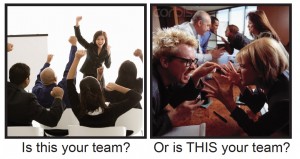In my work as an Executive & Life Coach, my area of expertise is relationship coaching, and specifically helping people create empowered, sustainable relationships. Now, the first thing that may come to mind is, “Why should I care about relationships, and what is a relationship coach doing writing an article for Project Mangers?” The truth is, life is all about relationships. In project management, the relationships you develop with your teams can be the difference between success and… well, something less.
In my previous career, I spent 25 years working for a world-class manufacturing organization, with more than 16 years in management, leading teams and working on hundreds of cross-functional projects over that time. I worked on everything from new product development, to process-related changes, to a 3+ year, $60 million dollar ERP project as a Business Process Owner. In other words, I have some credibility when it comes to this topic.
As Project Managers, we are always seeking ways to ensure greater success for our projects. At the very least, we seek to understand our past failures and mitigate circumstances as we become aware of challenges. I’ve been involved in many such meetings, where we seek answers to the question of, “What went wrong?” Typically there were as many answers to that question as there were people in the room.
We would hear everything including lack of planning, unclear expectations, competing priorities, to pretty much any reason you can think of to explain why things didn’t go the way we had envisioned. One inescapable truth that always was present, although not always articulated, was that the team was made up of a group of people from multiple functional areas of the company, with a broad range of skills, separate agendas, competing priorities, interfering bosses, and diverse personalities. Oh, and the PM “in charge” of the project had no direct line authority over any of them. Gee, what could possibly go wrong in that scenario?
I have always been fascinated by people. For the last 25+ years, I have been searching for answers to the question, “Why do people do the things they do?” The undeniable fact is that everything we think, say, or do is done to meet a need on some level. The question is whether we’re meeting the need through conscious choice or unconscious reaction. Ah, that’s the catch!
The foundation of my work is built upon a concept called Human Needs Psychology1. The premise is that all humans have the same six basic needs. How we prioritize those needs in the context of our own lives determines the decisions we make on a consistent basis. Understanding how others prioritize their needs can provide a method for communication and change management that goes far beyond the norm. It is like having a master key that unlocks the mysteries of human behavior.
Here are the Six Basic Human Needs:
- Certainty – We all want to feel safe, to avoid pain, and feel comfortable in our environment. Every individual needs some sense of certainty and security – knowing that our basic needs are being met. Some of the key words for certainty are comfort, security, safety, stability, protection, and predictability.
- Uncertainty/Variety – We need variety and challenges that will exercise our emotional and physical range. Everyone needs some variety in their life. Key words for variety are fear, instability, change, chaos, entertainment, suspense, surprise, conflict, and crisis.
- Significance – Every person needs to feel important, needed, and wanted. Significance comes primarily from comparing ourselves to others, and we question our superiority or inferiority. Key words for significance include pride, perfection, evaluation, discipline, competition, achievement, performance, and rejection.
- Love/Connection – The fourth need is to experience love and connection with others. Everyone needs to feel connection with other human beings, and everyone strives for relationships that give them love. Some of the key words for love and connection are togetherness, unity, teamwork, warmth, and desire.
- Growth – When we stop growing we die. It’s a biological imperative in nature, and in human beings we seek to grow intellectually, spiritually, and emotionally. Some people will satisfy their need for growth by reading new books or working out. Others might challenge themselves by taking on new initiatives. Key words indicating growth are development, inspiration, challenge, and learning.
- Contribution – This is about going beyond one’s needs in order to make a contribution beyond yourself, and to give to others. It is essential to feelings of fulfillment and happiness. This can manifest itself in the workplace through mentoring programs and training that seeks to improve the individual in meaningful ways. Some key words are giving, mentoring, generous, and helpful.
The response to change from a person who values certainty will be dramatically different from someone who values significance. Likewise, the person who values variety will react differently than the person who favors contribution. Knowing how these differing viewpoints can create clearly identifiable patterns can give you clues and information as to how you may best respond when working with your teams.
So how can you use this information to help create more effective, connected teams? Over the next two days, I’ll be posting articles to give you some insights into that very question.
1Human Needs Psychology is a process for explaining human behavior that was first proposed by Anthony Robbins based on his interventions with more than 3 million people around the world. The premise is that we all have patterns of behavior, and once understood, those behaviors can be changed to produce positive results.
